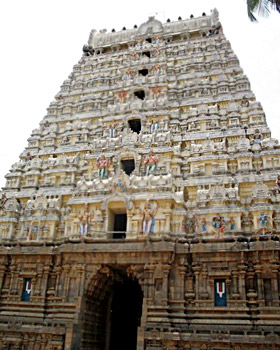 Association of Nayakas with temples translated into a number of benefits for the former. The Nayakas had essentially emerged strong in the sixteenth century as feudal landlords with extensive control over their territories. The Nayakas reaped a number of benefits from their overlordship and many of these advantages stemmed from their association with the temples. The best example of this aspect is seen in the case of Achyutappa Nayaka. He is said to have obtained the watchmanship (Talarikkam) over more than thirty-eight villages of the Srimushnam temple, a share in the administration of the said temple (Sthana Nirvaham) and the guardianship of the treasury (Tirmeni Kival) of the temple, for his donation of many properties including villages, and for his kindness in getting Kondama Nayaka to grant certain privileges to the temple. Since these rights were given as Kaaiyatchi, they are believed to have brought a considerable amount of income to Achyutappa Nayaka. It is also not difficult to suppose that Talarikkam was paid in the form of dues taken from each village and that the remuneration of Sthana Nirvaham was probably given as Kani land to him by the temple authority. A share in Prasadam must also have been a source of considerable income.
Association of Nayakas with temples translated into a number of benefits for the former. The Nayakas had essentially emerged strong in the sixteenth century as feudal landlords with extensive control over their territories. The Nayakas reaped a number of benefits from their overlordship and many of these advantages stemmed from their association with the temples. The best example of this aspect is seen in the case of Achyutappa Nayaka. He is said to have obtained the watchmanship (Talarikkam) over more than thirty-eight villages of the Srimushnam temple, a share in the administration of the said temple (Sthana Nirvaham) and the guardianship of the treasury (Tirmeni Kival) of the temple, for his donation of many properties including villages, and for his kindness in getting Kondama Nayaka to grant certain privileges to the temple. Since these rights were given as Kaaiyatchi, they are believed to have brought a considerable amount of income to Achyutappa Nayaka. It is also not difficult to suppose that Talarikkam was paid in the form of dues taken from each village and that the remuneration of Sthana Nirvaham was probably given as Kani land to him by the temple authority. A share in Prasadam must also have been a source of considerable income.
The Nayakas` close association with temples in this manner must have brought in more than the income they were entitled to. The case of Tirumalai Nayaka of Padaividu is significant. Though it is not exactly known in what capacity, he is known to have appeared as one of the temple authorities, or as acting on their behalf, in assigning temple land to a certain individual. He himself appears as a lessee of a temple village in the form of Maiaiyan Kattu Kuttagai.
These instances therefore illustrate how the Nayakas benefited from their association with temples. The lease system must have been utilized as an apparatus through which Nayakas could increase their strength in the locality. This is probably one of the prime reasons for the great enthusiasm of Nayakas in the sixteenth century in making charitable donations to temples, apart from perhaps the element of genuine religious motivation. In addition, donations to temples gave Nayakas the opportunity of expressing their loyalty to their superior, from which they must have derived benefits.






































